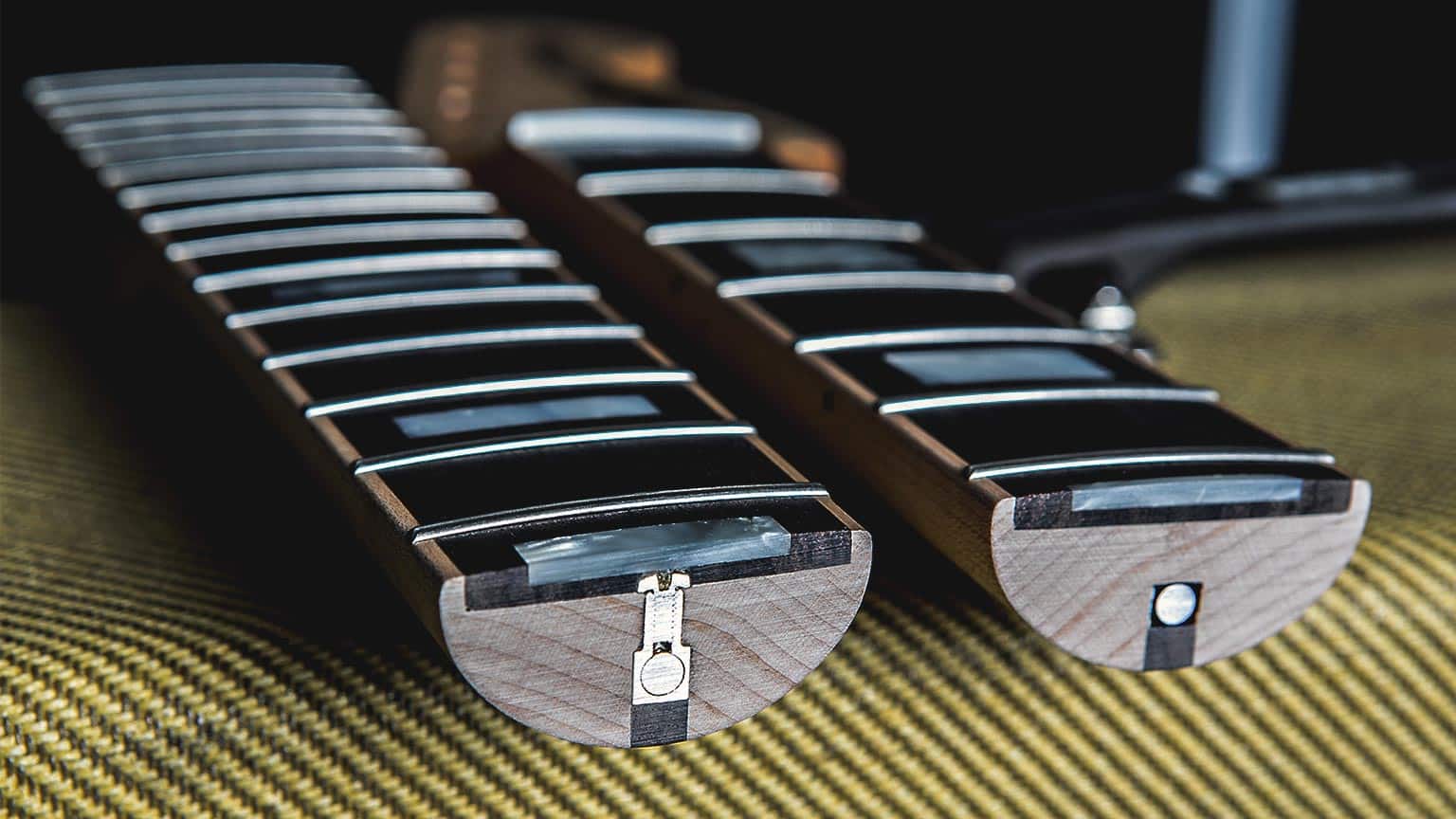Contents
Different guitarists have different ways to measure the playability of guitars but it’s widely agreed that the fretboard radius is an influential factor. Today, guitars on the market feature several options for the fretboard radius but 9.5 inches and 12 inches usually attract the most attention. Consequently, it’s not uncommon to see novice guitarists asking for opinions about 9.5 vs. 12 fretboard radius in forums. If you also want to hear what others have to say about the radius options before picking up your first guitar, I can help you.
Breakdown Of The Options

All in all, for the fretboard radius, those who like to hold chords usually favor 9.5 inches over 12 inches. On the other hand, the difference in size means 12 inches makes it easier to bend the strings for lower action compared to 9.5 inches.
In the end, it’s up to you to decide but if you prefer to be able to curve your fingers naturally, go for 9.5 inches. On guitars that feature a fretboard radius of 9.5 inches, you should have an easy time playing open chords and barre chords. The smaller the radius, the more comfortable you feel while making chords which is a big plus in draw-out performances. Prioritize guitars that offer 9.5-inch fretboard radius if you aim to be a rhythm player.
If you find yourself leaning toward the lead player, it’s suggested that you stick to guitars that come alongside a fretboard radius of 12 inches. For solos, you have to bend the strings a lot so you need to be able to move around the fretboard quickly. Large and flat fretboards facilitate movements so quite a few lead players consider 12 to be the winner in 9.5 vs. 12 fretboard radius. The lower action of 12 makes it popular among guitarists who appreciate the ease of pressing down strings too.
| 9.5 Inches | 12 Inches |
| -Permit natural curving of fingers -Comfortable to make choirs -For rhythm players | -Allow string bending -Facilitate movements -For lead players |
Top Models Available For Purchase
With 9.5-Inch Fretboard Radius
Fender Vintera ’60s Stratocaster Modified ($1,199.99)
Boasting a mix of vintage and contemporary features, Fender Vintera ’60s Stratocaster Modified is a solid model for up-and-coming guitarists. Thanks to the single-coil Stratocaster pickups, the Fender guitar packs enough power to match nearly every style of music. Moreover, the two-point synchronized tremolo ensures that owners of Vintera ’60s Stratocaster Modified can enjoy rock-solid tuning. Last but not least, the chrome hardware and satin finish contribute to the aesthetically pleasing appearance of Fender Vintera ’60s Stratocaster Modified.
Pros
- Stable
- Good-looking
- Adaptability is tip-top
Cons
- Not for lefties
- Limited color choices
Fender Affinity Series Stratocaster H HT ($319.99)
New to the world of guitars and desire a beginner model? Then it’s strongly recommended that you spare a bit of time to check out Fender Affinity Series Stratocaster H HT. The thin and light body of Affinity Series Stratocaster H HT means you don’t have to train your muscles to manipulate it. Aside from that, the humbucker bridge pickup of the Fender guitar provides a massive tone and should be able to accommodate you across levels.
Pros
- Reasonable price
- Second-to-none handling
- Resilient
Cons
- Plain
- So-so post-purchase support
With 12-Inch Fretboard Radius
Gibson Les Paul Standard ’60s ($2,999)
If you have money to spend and wish to own a high-quality guitar, you must add Gibson Les Paul Standard ’60s to your shortlist. Carrying SlimTaper-profile neck and silky-smooth rosewood fingerboard, the guitar from Gibson is unmatched in its range in terms of playability. Moreover, the presence of 60s Burstbucker pickups and handwired electronics enables you to shape the tone of Les Paul Standard ’60s to your liking. While Gibson Les Paul Standard ’60s appears kind of costly at a glance, its values match its price tag.
Pros
- Fantastic finish
- Sound quality is superb
- Bag included
Cons
- A bit expensive.
- The tuners might be a deal breaker for some guitarists.
Gibson ES-335 Sixties Cherry ($3,499)
Versatile and flexible, Gibson ES-335 Sixties Cherry is held in high esteem by guitarists around the globe. By taking advantage of the Vintage Deluxe tuners and Keystone buttons, you can gain total control over the tone of ES-335 Sixties Cherry. Furthermore, the fact that the pearloid-inlaid rosewood fingerboard is hand-rolled on a rounded C mahogany neck delivers a terrific feel over long playing sessions. Finally, the nickel hardware and silver reflectors of Gibson ES-335 Sixties Cherry guarantee incredible presentation.
Pros
- High level of control
- Dependable and reliable
- Enduring
Cons
- Pricey
- Action can drop low in high humidity
Common Fretboard Radius Options For Guitars

While 9.5 inches and 12 inches show up many times in discussions about fretboard radius, other options exist and they have their fair share of popularity. Down below is a list of options for the fretboard radius that you may find while browning guitars
- 7.25 inches
- 9.5 inches
- 12 inches
- 16 inches
- …
Note: Not all guitars offer the same set of fretboard radius options. Even if models come from the same brand, there is still a chance that they offer different options for the fretboard radius. Research carefully before making purchase to get the most out of your money.

Hi music fan! I am Jeff. Hope that you enjoy some stuff I shared here in my personal blog.
About myself, Currently I am in charging as Artist Manager/Music Supervisor at 72 Music Management. I did managed album to Grammy Award in 2017 with 7 Nominations from 2014-2020 and had the opportunities to work with : A.J. Croce, Blind Boys of Alabama, Bobby Rush, Dom Flemons, Dustbowl Revival, Sarah Grace
Governor of the Memphis Chapter of The Recording Academy is one of a award that I am lucky to achieved.
